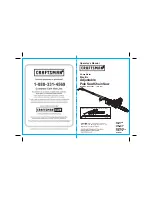
29
28
MAINTENANCE AND STORAGE OF CHAIN SAW cont.
MAINTENANCE AND STORAGE OF CHAIN SAW cont.
3. Maintain chain saw with care.
• Never expose saw to rain.
• Keep chain sharp, clean, and lubricated for better and safer performance.
• Follow steps outlined in this manual to sharpen chain.
• Keep handles dry, clean, and free of oil and grease.
• Keep all screws and nuts tight.
• Inspect power cord often. If damaged, have repaired by authorized service center.
• Never carry chain saw by power cord.
• Never yank power cord to unplug it.
• Keep power cord from heat, oil, and sharp edges.
• Inspect extension cords often and replace if damaged.
4. When servicing, use only identical replacement parts.
5. When not in use, always store chain saw
• in a high or locked place, out of children’s reach • in a dry place
BAR MAINTENANCE
To maximize bar life, the following bar maintenance is recommended.
The bar rails that carry the chain should be cleaned before storing the tool or if the bar
or chain appear to be dirty.
The rails should be cleaned every time the chain is removed.
Turn the bar over, top rail becoming bottom and bottom rail becoming top,
around every 5 hours of use.
Keep chain sharp. Your saw will cut faster and more safely.
A dull chain will cause undue sprocket, Guide Bar, chain, and motor wear.
If you must force chain into wood and cutting creates only sawdust with few large chips,
chain is dull.
SHARPENING SAW CHAIN
TO CLEAN THE BAR RAILS:
1. Remove chain cover and bar and chain.
(see section ASSEMBLY)
2. Using a wire brush, screwdriver or similar tool,
clear the residue from the inner
groove of the bar. (See Fig. 22)
3. Make sure to clean oil passages thoroughly.
CONDITIONS WHICH REQUIRE GUIDE BAR
MAINTENANCE
•
Saw cuts to one side or at an angle.
•
Saw has to be forced through the cut.
•
Inadequate supply of oil to the bar and chain.
Check the condition of the Guide Bar each time
the chain is sharpened.
A worn Guide Bar will damage the chain and
make cutting difficult. After each use, with unit
disconnected from power source, clean all sawdust from the Guide Bar and sprocket hole.
Replace the Guide Bar when the groove is worn, the Guide Bar is bent or cracked, or when
excess heating or burring of the rails occurs. If replacement is necessary, use only the Guide
Bar specified for your saw in the repair parts list or on the decal located on the chain saw.
Fig. 22
When rail top is uneven, use a flat file to restore
square edges and sides.
WARNING:
Unplug chain saw from power source before servicing.
Severe injury or death could occur from electrical shock or body contact with
moving chain. Cutting edges on chain are sharp. Use protective gloves when
handling chain.
!
Note:
It is not necessary to remove the chain or bar when lubricating the sprocket
1. Clean the bar and sprocket.
2. Using a grease gun, insert the tip of the gun into the
lubrication hole and inject grease until it appears at the
outside edge of the sprocket tip. (See Fig. 24 )
3. To rotate the sprocket release the chain stop and pull
the chain by hand until the ungreased side of the
sprocket is in line with the grease hole.
Repeat the lubrication procedure.
LUBRICATE SPROCKET
WARNING:
Wear heavy duty gloves when performing any maintenance
or service to this tool. Always unplug the tool before performing any service
or maintenance on this tool.
!
EN: Injecting grease to lubricate
ES: Inyectando grasa para lubricar
Fig. 24
Worn Groove
Correct Groove
File Rail Edges
and Sides
REPLACING BAR & CHAIN
Replace chain when cutters are too worn to sharpen or when chain stops.
Only use replacement chain noted in this manual.
Always include new Drive Sprocket (call-out 15 on Fig.1), when replacing chain.
This will maintain proper driving of chain.
Inspect Guide Bar before replacing chain.
A worn or damaged Guide Bar is unsafe.
A worn or damaged Guide Bar will damage chain.
It will also make cutting harder.
Fit the Bar Tensioning Plate catch (call-out 22 on Fig.1)
into the new bar by tightening the screw clockwise.
The catch protrude (a) must be fitted into the bar hole.
(See Fig. 23)
Fig. 23
a



































